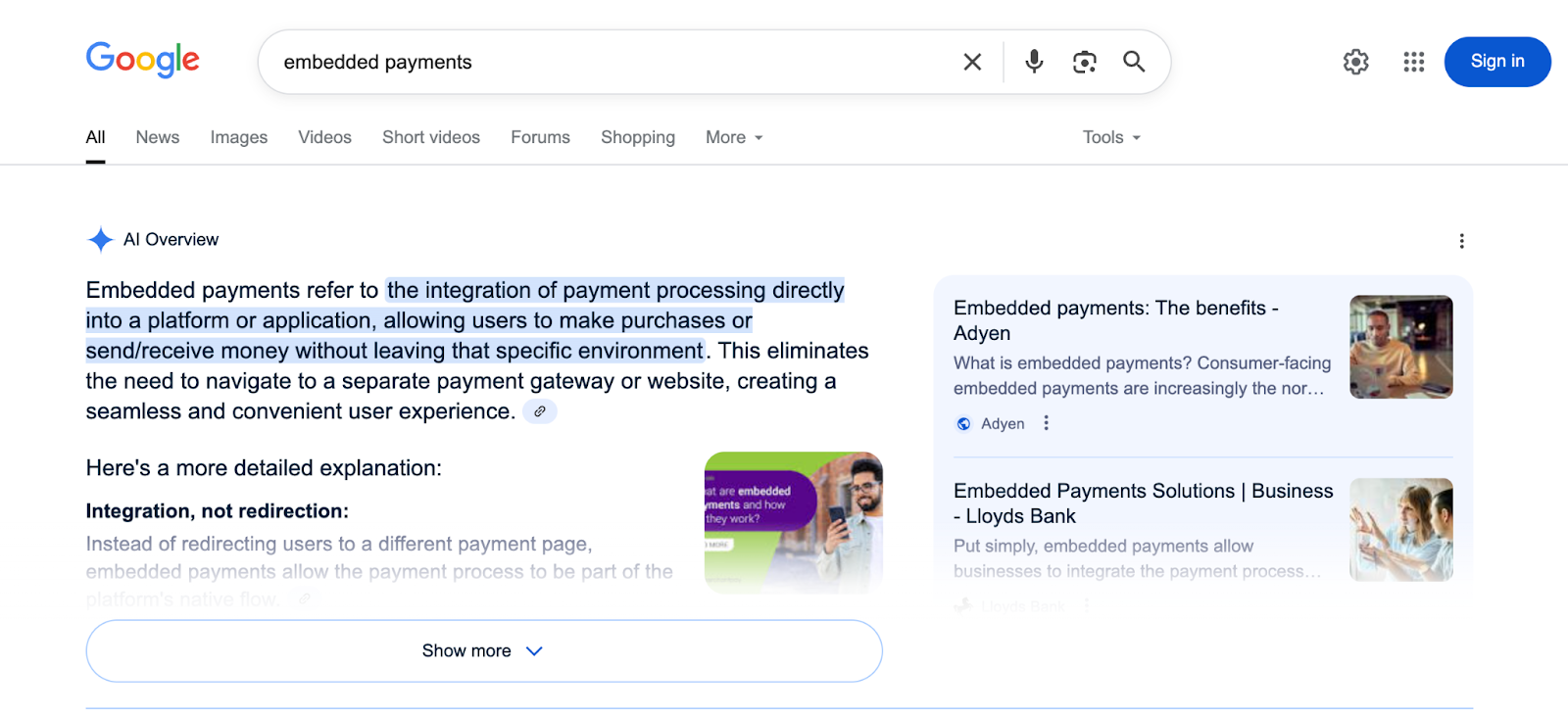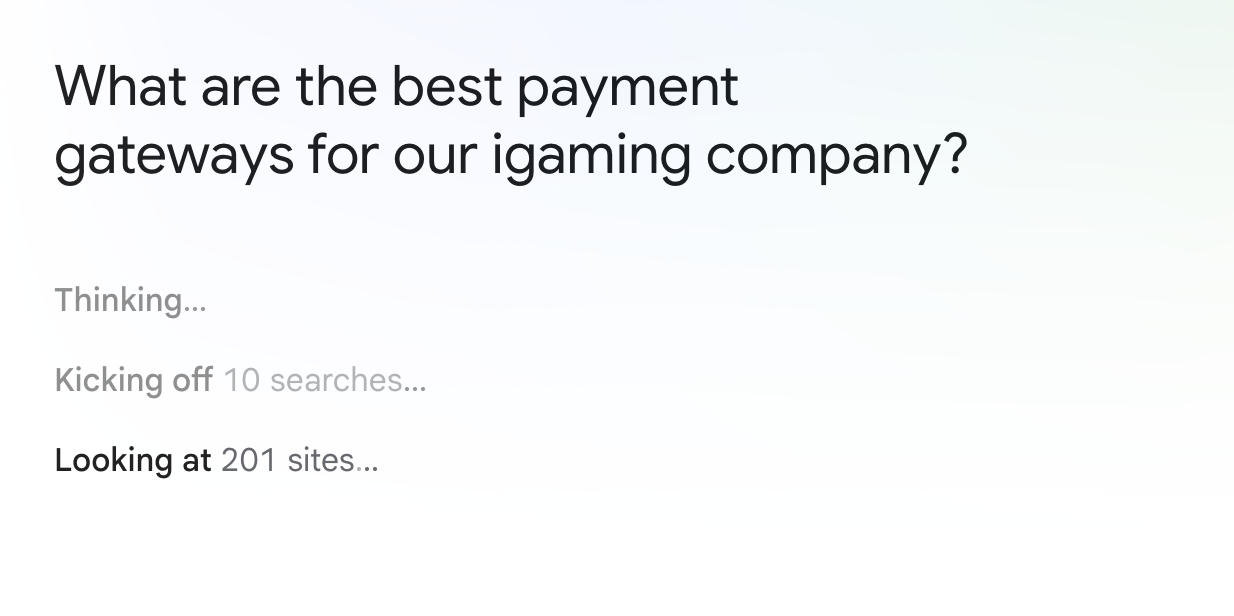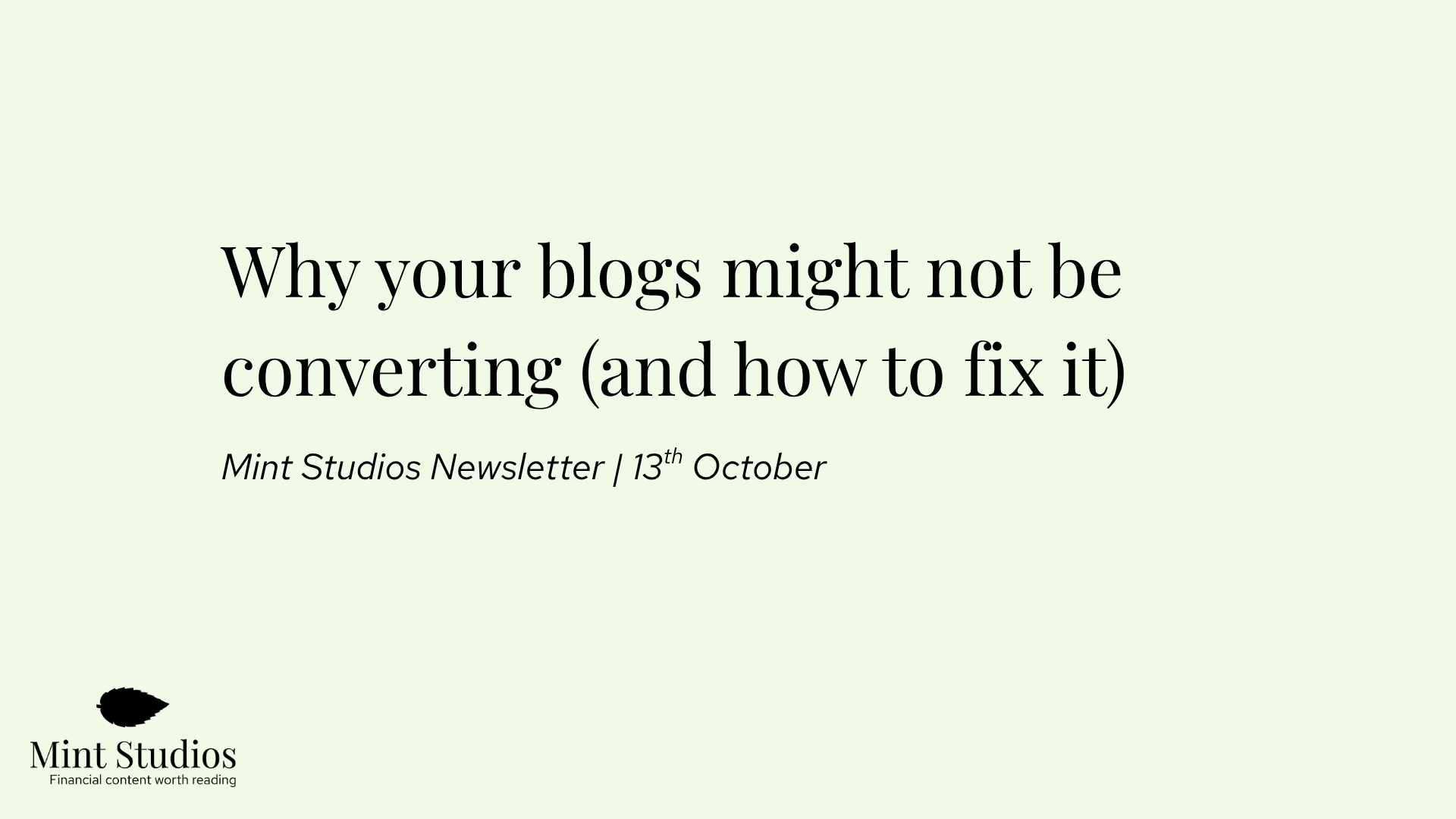AI Mode, Google’s new search feature transforming the main page of Google into a conversational AI tool, was first announced on the 5th of March 2025, and marked the beginning of a new way many of us will search online.
As of August 2025, it’s already been rolled out in the US and the UK, and there is a clear assumption that this will be the default search experience when people head to Google.
The world of content marketing has already changed so much with AI Overviews, LLMs like ChatGPT and new AI processes which completely overhaul how people write. But with AI Mode, things are about to change even more, and I think it’s worth exploring what it means for marketers.
We’ll dive into
- What is AI Mode and what are the implications for marketers?
- How will AI Mode affect your content marketing and SEO?
- What you can do to prepare: embrace specificity
- What can you do now?
Want to get updates every time we publish a new piece? Join our newsletter! We send these out every 2 weeks.
What is AI Mode and what are the implications for marketers?
How it works
To fully explore how AI Mode will affect the world of content marketing, I recommend you first play around with it and test for yourself. If you’re not in the UK or the US, you can see for yourself how it works through this link (you may have to set your VPN to either of those countries): https://www.google.com/search?udm=50&aep=11
When you first start testing it, you’ll see what everyone means by “this is fundamentally changing the search experience”. Whereas before we (kind of) had 10 blue links to relevant search results including blog posts, landing pages, videos, research studies and more, now, users are interfacing directly with an AI. Basically, everyone will be using a ChatGPT-like experience to do research online.
Before we explore the implications of this new search experience on how people will do research and buy products, it’s worth spending some time explaining how AI Mode / Gemini works.
If you're already familiar with AI Overviews – the AI-generated piece of text at the top of the search when you use Google – AI Mode expands on this model with more advanced logic to answer more complex questions. AI Mode is essentially an expansion on AI Overviews.

Google further explains what AI Mode entails:
“This new Search mode expands what AI Overviews can do with more advanced reasoning, thinking and multimodal capabilities so you can get help with even your toughest questions. [...]
Using a custom version of Gemini 2.0, AI Mode is particularly helpful for questions that need further exploration, comparisons and reasoning. You can ask nuanced questions that might have previously taken multiple searches — like exploring a new concept or comparing detailed options — and get a helpful AI-powered response with links to learn more.”
The same LLM that is used to generate AI Overviews will be used for AI Mode (just tweaked slightly with a custom version, as Google says above). This is important because it means that if your brand is regularly appearing in AI Overviews, then chances are it will appear in AI Mode as well.
Having said that, one key difference with AI Mode is that instead of relying on just one query (like AI Overviews), it uses a “fan-out” technique where it issues multiple queries at once. You can see this in real-time when you type queries into AI Mode yourself. You’ll see the AI mode thinking live and the process it uses which involves completing multiple searches and looking at hundreds of sites before giving an answer.

The key point here is that the method used by AI Overviews / Gemini to retrieve information differs from Google’s 10 blue links. Instead of indexing the web and pulling high-authority pages, AI mode uses “passage-level retrieval”. This means it’s looking for specific phrases and content (rather than entire pages) that help answer the user’s queries.
Instead of just retrieving the top-ranking results for a keyword, the AI assesses a cluster of related questions, then fans out to analyze the whole set of web content, including pages that are further down the rankings, to offer a strong summary.
This is why AI Overviews and AI Mode will often quote passages and content from websites that are ranking on the 5th page of Google rather than those in the top 5 positions.
This is crucial to understand if you want your article to be sourced in AI Mode: the LLM is essentially breaking your article down into short passages, and will retrieve specific segments rather than entire articles.
On a more technical level, what they’re doing is embedding those passages into a “vector space”. Each passage in your article is allocated a string of numbers that is unique. The LLM then compares the unique string of numbers in a user’s query to the one created within your passage. If they are similar (the term is ‘cosine similarity’) enough, then your passage will appear. This allows the LLM to match context, meaning and intent.

Image from Matthew Manela on how LLM embeddings work
This is different to SEO in the sense that instead of looking at a whole page, Gemini is evaluating specific passages within your article.
What does all this imply?
For AI Mode, the main implication is that instead of optimizing for a specific keyword, you'll be optimizing specific passages to be relevant for specific queries. As we’ll see, this is why it’s more important than ever to make sure your content is specific, succinct and to the point (I believe it’s also why FAQs seem to perform so well: they answer a question in a very straightforward way). If not, Gemini will struggle to source a specific segment.
Another implication is that we may be entering a world where we are marketing to bots rather than humans. If bots are the primary “consumer” of information because they then interpret it for the end user, that means you want your content to be optimized and readable by bots.
As a marketer, that means you have to:
- Influence your users through more channels such as Google Ads, PR and social
- Optimize your content at the passage level to be similar semantically to what your users are searching
- Understand how you’re appearing on these tools
Instead of backlinks, keywords and word count, what matters is relevance, or what Michael King in his fantastic article on How AI Mode works calls “Relevance engineering”. It’s about aligning your content with what Google’s AI Mode thinks the user means.
The days of chasing rankings may also be over. As Google turns more into a native LLM than an engine to search sites and pages, it wants content assets that are relevant to user intent and easy to understand and use in its responses. Users can now ask one question and continuously refine it instead of searching for a specific solution or information to take action. This includes questions about images and voice, not just text.
As a marketer, this means:
- Your content doesn’t have to rank #1 to appear in AI mode. Because of the fan-out mode, being further down the page can still get your brand to surface in AI mode.
- Semantic relevance and clarity are more important than classic SEO tactics like “adding secondary keywords”. In this fascinating study by UC Berkeley professors, the authors found that LLMs prioritized sources that were relevant to the questions over authority.
- Authority is still important, but relevance comes first. After fan-out mode, AI mode does select for authority. But if you don’t pass the similarity threshold, authority won’t matter.
How will AI Mode affect your content marketing and SEO?
What does the full launch of AI Mode as the default search engine mean for content marketing?
One key shift is understanding that the way tools are interpreting your content will change. With SEO, your content comes out the same way it goes in. Readers see what you wrote.
With generative AI and AI Mode, your content is manipulated. You have no idea how it will appear and whether AI will use it to give the response you intended. This is what is so different.
Considering how AI Overviews have impacted SEO and content, here are a few ways I think AI Mode could affect your content marketing:
Traffic will decrease even more
It’s clear that as more people get answers to their queries within AI Mode, the need to visit a page or website will decrease. We’ve already seen an average of a 34.6% decrease in organic traffic due to AI Overviews, and that was while we mostly still had 10 blue links and just an AI summary at the top.
It’s fair to assume that when AI Mode becomes the default, traffic will decrease even more.
A decrease in traffic doesn’t necessarily have to be a bad thing, because ultimately your target customer is still consuming content; it’s just in a different place (within AI Mode). What gets harder here is attribution (we’ll explore how to adapt as a marketer further below).
“Rankings” won’t matter as much anymore. What matters is influencing AI
With AI Mode, you’re not optimizing for a specific keyword, and there is no longer a clear list from 1 to 10 of the top positions. Instead, you have just one answer. It also updates every day, and each person may see something different.
With this, traditional SEO strategies may not be so relevant: building backlinks, targeting one keyword and writing SEO blog posts won’t help as much. Instead, you’re figuring out how to influence the AI. In this case, it’s likely to be content that succinctly, clearly answers the phrases that AI is searching. We explore what that looks like in practice below.
Attribution will get even harder
This will likely be the biggest challenge we face as marketers when AI Mode is fully deployed. With traffic and pageviews, it was easy to see if your content was being read: if pageviews were increasing, then people were reading it and you were “influencing” them in some way.
Now, your content is being interpreted, and the answer Gemini gives the user could or could not include your website as a source. So far, Google has not shared how or if they will allow marketers to see how they are turning up in AI mode, and you still can’t filter data in Search Console to differentiate between traditional search, AI Mode or AI Overviews.
The only way you know if you’re being sourced is if:
- You use a third-party AI tracking tool like Profound, Scrunch or Peec
- You check it yourself manually
- The user clicks the source, reads the content and the UTM link allows you to track pageviews in GA4 (which people may do less and less)
What you can do to prepare: embrace specificity
At the Fintech Marketing Conference in July 2025, I gave a talk on this exact topic (“What we know about appearing on LLMs”) and I finished with this: what can we do to prepare?
First of all, I want to make something clear: we don’t need to panic. As marketers, we’ve gone through many waves of changes. Remember when ad blockers first came out and everyone worried about how to reach people with digital ads? At first there was a lot of worrying, but marketers adapted, shifted budget and uncovered a new channel that is now huge and a big part of marketing: influencer marketing.
Once again, we have to adapt. With AI, marketing is shifting, and we’ve got to figure out how to make the most of this channel. Through our own experiments with clients, we’ve uncovered a few key practices that matter in the age of AI Mode.
Mainly, what I’m seeing is that we are entering a world of specificity. LLMs can only source your brand or content if it’s very clear about what you do and how you differentiate. The brands that are tightly positioned and specific will come out ahead of those that aren’t.
In terms of content marketing, I see that in:
- How you write
- What you write about
- Where you appear
How you write: Content is still key, but how you produce it may be different
Content is required for LLMs to answer queries, so, interestingly, I actually think that content will become more important in the age of AI, rather than less.
However, the classic SEO strategy of creating an article and targeting one keyword may not work as well. That’s because, as we mentioned above, what matters now is being semantically relevant within one specific passage.
In practice, this means that you want your content to be succinct and specific. You may no longer need to “tell a story” or “paint a picture”. Instead, you need to get to the point. You may no longer need 1,000+ word articles on the topic of “payment authorization”. Instead, you need five separate 300-word articles that cover different aspects of the topic in a way that is very specific and clear.
You also need to have a very strong understanding of your target customer. What are the most common queries and questions that your target audience would put into AI mode? Although I’m sure that more tools will help us do this analysis, none of them will ever be able to uncover the different millions of variations to the phrase “How do I improve payment authorization rates?”. A deep understanding of the customer will be now more important than ever.
What you write about: Bottom of the Funnel matters a lot more
It’s clear that the Top of the Funnel content is becoming less relevant. Someone typing into AI mode “what is a SEPA Direct Debit” is clearly searching for information and is likely to be satisfied with the answer that comes up in AI Mode. They are unlikely to visit your site because AI mode has answered their query fully.
But there is one point where they will have to visit your site: when they’re ready to buy. They’re ready to pick a payment provider and need to understand which one is the best fit for them. Users still need to visit a website to complete key tasks such as buying a product or booking a service, and for this reason, bottom of the funnel searches and brand searches will continue to drive traffic to your website. Although buying concert tickets could soon be done completely by ChatGPT, a high-value purchase like picking a payment provider, an identity verification solution or even business insurance, I think, will always require a visit to a website.
However, the user will only land on your website if you actually turn up when they type into AI Mode “Top payment gateways for iGaming”. You may offer the best payment services around, but if you don’t turn up, the user will not visit your website.
This is why it’s more important now to concentrate your marketing and content efforts on the Bottom of the Funnel and ensuring your brand actually does turn up at those crucial moments. That means creating content like:
- Best of (e.g., Best payment providers for iGaming)
- Comparison posts (e.g., Xero vs Quickbooks)
- Pain points (e.g., Amex business card no fees)
- Use cases (e.g., Payment processing for travel industry)
Luckily, this is the type of content we’ve been creating since we first set up our agency, and it’s clear that this is now a key content type to appear on LLMs. If you want to read up on what BOFU content is and how to get started creating this type of content, check out the following articles:
- What is BOFU (Bottom of the Funnel) Content and Why Is it Important?
- How to Do Research for Bottom of the Funnel Content Marketing
- Why You Should Write About Your Competitors as a Fintech Company
Where you appear: tight positioning is more important than ever
The last piece of this puzzle is the positioning of your company and where it appears. There is extensive evidence that digital PR, appearing on many publications and third-party sites, will help improve your visibility in LLMs.
But what’s important here is to have strong positioning. If you appear on a “Top payment providers” list as well as a “Top payment orchestration companies” list, the LLM may get confused and quote you as the wrong tool.
In other words, what’s key here is to have a strong brand identity (knowing what you want to be known for), and making sure your messaging is consistent across all your pages and blog posts and that external sources present you in the right way.
Tom Davies, VP Marketing at Yonder, shares in a Substack newsletter how this approach helped them grow their visibility on AI search from 11% to 21%. They already had tight positioning, so what they did was make a list of all the sources ChatGPT was using to to generate answers, and then share it with their affiliate marketing agency. The agency started to build relationships and land placements on those specific publications, and this is what helped grow their overall visibility.
The main takeaway here is: having tight and clear positioning and messaging is very important to ensuring LLMs quote you correctly. But doing it on your own website is not enough, you also need that messaging to be clear across publications, news sites and other websites.
What can you do now?
There’s a lot to take in. Marketing in the age of AI is moving so quickly, and now we need to prepare for the further changes that AI Mode will bring.
If you’re a marketer who wants to be prepared, here are my suggestions for adapting to AI Mode:
1. Move away from traffic as a key metric
It’s clear that traffic is no longer a good indicator of how well your content is working. Instead, you can track other metrics:
- Conversions: first, last and multi-touch. We’ve written an article on how to do that here: How to Measure the Impact of Content Marketing in a Fragmented SEO Landscape
- Inbound leads via LLMs: this tells you if people are using LLMs to find your company. We’ve found that the most accurate way to track this is to add a “How did you hear about us?” field in your contact form to track that.
- High-level metrics such as impressions.
In any case, it’s important to communicate to executives that the focus is now on conversions, not traffic.
2. Create a list of queries you believe your prospects would be typing into LLMs, and start creating succinct, short content that answers those
If your ideal customer were using AI Mode right now, what type of questions would they type? Maybe you can organize a brainstorming session with sales, customer success and any other customer facing role who wants to join and put together a long list of all the queries they would be using.
Start creating content that answers those questions and make sure to follow best practices shared by the study done by UC Berkeley professors: answer the query within the first sentence, and keep the content very succinct.
3. Start creating more BOFU content
According to research by the Profound, a tool that tracks your performance in AI search, comparison posts and “Top X” posts are sourced 32% of the time, whereas regular articles are sourced 9% of the time. It may feel uncomfortable to do these types of articles, but they work very well, and it’s worth creating them as part of your plan. Here’s a way to write these articles in a way that is honest and transparent: Why You Should Write About Your Competitors as a Fintech Company
4. Build partnerships
With AI Mode, it’s crucial for teams to work with each other. Appearing on AI Mode requires working with the PR or affiliate team to appear on lists, publications and key affiliates. It also requires working with the video team to appear on video and audio searches.
AI Mode: the key to success adaptability and experimentation
How AI Mode picks sources is different to SEO, so although the two have quite a bit of overlap, they are different beasts. It’s too early to say that SEO is no longer important – it’s still clearly key to appearing on Google which is still the highest performing channel for many companies. But we are at a turning point where it’s very possible that optimizing for an online digital presence will require having a deep understanding of how LLMs work.
As a marketer, the best thing you can do is go deep into AI Mode to understand how it works, how your prospects would be using it and then set up your own tests and experiments to figure out what you can do to influence the AI.
On our end, we’ve been running “AI pilots” across most of our clients to see what does and doesn’t work (e.g. FAQs seem to play a role in influencing LLMs) – if you operate in the financial services or fintech space and want to hear more about what we’ve seen does and doesn’t work, feel free to reach out to us. We’re happy to chat.











